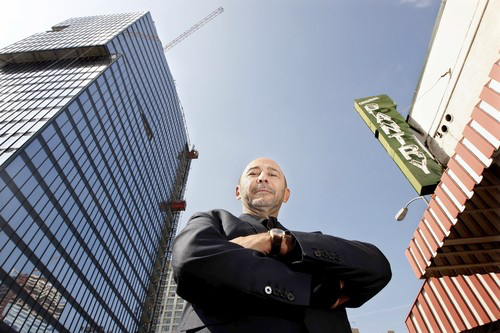Source :: LA Times dot com
Date :: 04.23.2009
By :: Roger Vincent

Christina House / For The Times
Hassan “Sonny” Astani overcame an exasperating sequence of setbacks and hurdles to build a 30-story condo tower and a six-story loft building on Figueroa Street. “I’m really betting the ranch,” he said.
The developer of the $300-million Concerto complex thinks he can beat the odds and find buyers.
When the Concerto high-rise condominium project opens this year in downtown Los Angeles, developer Hassan “Sonny” Astani will be lucky not to lose his shirt.
With the market for condos in woeful decline, he already knows he won’t make much money — if any.
Progress, at this point, would be to complete the $300-million project while staying out of bankruptcy. Astani’s struggles to keep the project going, his flirtations with disaster and his near-heroic efforts to save a project that is woefully out of time with the market are a painful illustration of the difficulties that face developers when boom goes bust.
Theirs is a business with a long timeline — it takes years to bring a large project to fruition. But a lively market can go bust in a matter of months. And then what do you do?

Detail of project.
“There is a huge inventory of unsold condos in downtown L.A.,” said Delores Conway of the USC Lusk Center for Real Estate. “The supply is exceeding demand.”
This month, the owners of the nearby Roosevelt Lofts filed for Chapter 11 bankruptcy protection after failing to sell enough condos to open the elaborately renovated office building to residents. Owners of the Brockman Building, another downtown condo project, also recently filed for bankruptcy protection.
Astani, an Iranian immigrant who adopted the nickname Sonny as a boy because he liked the singing duo Sonny and Cher, had a successful track record as an apartment and condo developer before tackling Concerto. It would be the 55-year-old’s biggest project, filling a city block in the financial district with three buildings and a park.
But in 2007, after he had invested three years and $10 million, things started to go south. His bank had pulled out, his financial partners in Singapore wanted to walk away, and the once-hot condo market was losing steam. All he had to show for his time and money was a four-story hole in the ground across Figueroa Street from the Original Pantry restaurant.
Astani, who had been broke earlier in his career, was tempted to cut his losses. “People told me to stop,” he said.
If the site, once a parking lot bringing in $1.2 million a year, went back to a block of smooth asphalt with painted white stripes, he could at least recoup a little money.
Instead, he pushed on through an exasperating sequence of setbacks and hurdles to build a 30-story condo tower and a six-story loft building, buying out his overseas partners and personally guaranteeing his loan, a risky move developers almost always avoid. He credits his practice of tai chi with teaching him to focus, stay calm and persist.
The condos are coming to market in the midst of one of the country’s worst housing crashes. The sales office opened last week, but no deals have been closed so far. The condos may or may not sell soon enough to make the developer any money. But the project’s back story is also Astani’s, and it proves his motto: “You have to have a Plan B and a Plan C.”
The whole Concerto saga started with a fairly big risk when Astani paid $30 million for the 100,000-square-foot parcel in 2004, one of the highest prices per square foot ever paid for downtown land.
“It was a leap of faith that this would be the next big place,” he said, because other developments, including a Ralphs supermarket and the $2.5-billion L.A. Live project, were planned for surrounding blocks. Both have come to pass, but the residential market is still soft.
Astani started digging a hole for the four-story underground garage in early 2007, but his construction lender, Fremont Investment & Loan, bailed out of commercial real estate lending under pressure from federal regulators. Astani had to stop work. He lined up another loan from Corus Bank, but his main financial partners in Singapore decided to get out.
“They wanted to stop wrestling with two banks,” he said. Astani and a handful of remaining partners bought out the Singapore partners for $30 million and carried on, he said.
Meanwhile, even though credit markets were seizing up, construction costs were still rising in response to a long-running global real estate boom that had driven up demand for labor and materials such as steel and lumber. Astani calculated that he could save $15 million by taking over the role of general contractor. His lenders went along, but that put his financial neck on the line.
“I had to guarantee that I would finish the building, sell the units and pay them. If I fail, they can come in and take my house” and other assets, said Astani, who lives in Pacific Palisades. “I’m really betting the ranch.”
He and his wife decided to press ahead, he said, after attending an ice-skating performance at Staples and seeing people out on the streets. “It’s clear to me that people want to live here,” he said.
Astani started as an industrial and systems engineer, with a degree from USC. But after six months in the field, he decided that he wasn’t making enough money. He became a real estate agent and went to work selling condos on the burgeoning Wilshire Boulevard corridor near Westwood.
For a few years, commissions rolled in and Astani felt like a big shot. “I dressed like ‘American Gigolo,’ ” he said, recalling the 1980 movie in which Richard Gere put Armani on the fashion map.
But the Wilshire condo market stalled, and Astani quickly ran out of money as he tried to keep up appearances. His black, two-seat Mercedes-Benz 450SL was repossessed, and he couldn’t pay his rent.
With help from his family, Astani got back on his feet. He and his brother, Marco, went back to school at Cal State Los Angeles and got contractors licenses. From the mid- to late 1980s they built apartment buildings on the Westside that they sold to investors, including Lakers owner Jerry Buss and his real estate partner Frank Mariani.
Residential development worked for Astani until the early 1990s, when the Southern California real estate market crashed again. This time he got by through marketing himself to banks that owned repossessed commercial buildings they didn’t want as someone who could manage properties while improving them for resale. He eventually started investing in some with Asian partners, which led him back to development in the 2000s as real estate again improved.
During his ups and downs, Astani learned to expect and prepare for bad times. He said the cycles have made him resilient — and willing to make changes in order to survive.
“Sonny has always figured out how to work out whatever is thrown in his path,” said Los Angeles City Councilwoman Jan Perry, who represents much of downtown. “He is very linear in his focus and plans everything he does very well,” .
Plans for a profit from the first stage of Concerto appear to be out the window, though.
Astani has cut prices substantially from what he set two years ago, with smaller units dropped to $400,000 from $575,000 and larger ones down to $590,000 from $800,000. He hopes the lower prices will make it easier for customers to finance the units with conforming loans backed by the federal mortgage companies Fannie Mae and Freddie Mac. He declined to say whether the prices had dropped below the break-even point.
“My priority is to sell these and pay off the bank,” Astani said. He’ll hang on to the penthouses in hope of getting as much as $3.5 million for them someday.
If the project stays afloat, Astani plans to build a second, complementary tower. “The tops of the buildings twist and turn — one tower moves in, the other tower moves out,” said architect Douglas Hanson. “The project will be stronger when the second tower is there.”
Hanson, of DeStefano + Partners, was project architect for Frank Gehry’s Bilbao museum design and has collaborated with the architect Renzo Piano. Hanson’s goal at Concerto was to make the project connect with the streets around it. “The whole block should be livable and urban, and not a big building sitting on a parking garage.”
The environmentally friendly development will have shops and restaurants at ground level, public green space and a park for the practice of tai chi.
Astani believes that someday his buildings will be full of residents, even if he has to help some come up with down payments. “In a hot market, people line up,” he said. “In a cold market, they still want to buy.”

Recent Comments